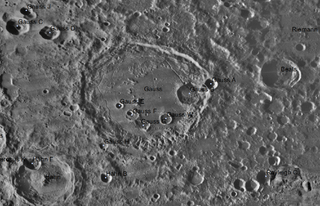Gauss (crater)
|
Oblique Lunar Orbiter 4 image | |
| Coordinates | 35°54′N 79°06′E / 35.9°N 79.1°ECoordinates: 35°54′N 79°06′E / 35.9°N 79.1°E |
|---|---|
| Diameter | 177 km |
| Depth | 3.6 km |
| Colongitude | 284° at sunrise |
| Eponym | Carl F. Gauss |


Gauss is a large lunar crater, named after Carl Friedrich Gauss, that is located near the northeastern limb of the Moon's near side. It belongs to a category of lunar formations called a walled plain, meaning that it has a diameter of at least 110 kilometers, with a somewhat sunken floor and little or no central massif. Due to its location, this crater appears considerably foreshortened when viewed from the Earth, and its visibility is affected by libration.
To the northeast of Gauss is Riemann, another walled plain that lies even closer to the limb. Southwest of Gauss is the crater pair of Hahn and Berosus. Almost directly southward is Seneca.
The rim of Gauss is better formed in the northern half, and the inner walls have some terracing along the northwest and appear slumped in the northeast. The southern half of the rim is somewhat more eroded.
The interior floor is fairly flat in places, with several craters marking the surface in the southern half. There is also a small crater, Gauss B, lying along the interior of the eastern rim, with the smaller Gauss A lying across the rim just to the northeast of Gauss B. The floor of Gauss is also marked by several clefts, particularly along the eastern and northwestern edges. The uneven crater rims in the south and a series of rises in the north gives the appearance of a ridge line that traverses the crater floor from north to south.
Satellite craters

By convention these features are identified on lunar maps by placing the letter on the side of the crater midpoint that is closest to Gauss.
| Gauss | Latitude | Longitude | Diameter |
|---|---|---|---|
| A | 36.5° N | 82.7° E | 18 km |
| B | 35.9° N | 81.2° E | 37 km |
| C | 39.7° N | 72.1° E | 29 km |
| D | 39.3° N | 73.8° E | 24 km |
| E | 35.3° N | 77.6° E | 8 km |
| F | 34.8° N | 78.3° E | 20 km |
| G | 34.2° N | 78.6° E | 18 km |
| H | 33.2° N | 77.1° E | 11 km |
| J | 40.6° N | 72.6° E | 14 km |
| W | 34.5° N | 80.2° E | 18 km |
External links
- Gaussian Blur, Lunar Photo of the Day, February 16, 2006
References
- Andersson, L. E.; Whitaker, E. A. (1982). NASA Catalogue of Lunar Nomenclature. NASA RP-1097.
- Blue, Jennifer (July 25, 2007). "Gazetteer of Planetary Nomenclature". USGS. Retrieved 2007-08-05.
- Bussey, B.; Spudis, P. (2004). The Clementine Atlas of the Moon. New York: Cambridge University Press. ISBN 978-0-521-81528-4.
- Cocks, Elijah E.; Cocks, Josiah C. (1995). Who's Who on the Moon: A Biographical Dictionary of Lunar Nomenclature. Tudor Publishers. ISBN 978-0-936389-27-1.
- McDowell, Jonathan (July 15, 2007). "Lunar Nomenclature". Jonathan's Space Report. Retrieved 2007-10-24.
- Menzel, D. H.; Minnaert, M.; Levin, B.; Dollfus, A.; Bell, B. (1971). "Report on Lunar Nomenclature by the Working Group of Commission 17 of the IAU". Space Science Reviews. 12 (2): 136–186. Bibcode:1971SSRv...12..136M. doi:10.1007/BF00171763.
- Moore, Patrick (2001). On the Moon. Sterling Publishing Co. ISBN 978-0-304-35469-6.
- Price, Fred W. (1988). The Moon Observer's Handbook. Cambridge University Press. ISBN 978-0-521-33500-3.
- Rükl, Antonín (1990). Atlas of the Moon. Kalmbach Books. ISBN 978-0-913135-17-4.
- Webb, Rev. T. W. (1962). Celestial Objects for Common Telescopes (6th revised ed.). Dover. ISBN 978-0-486-20917-3.
- Whitaker, Ewen A. (1999). Mapping and Naming the Moon. Cambridge University Press. ISBN 978-0-521-62248-6.
- Wlasuk, Peter T. (2000). Observing the Moon. Springer. ISBN 978-1-85233-193-1.
